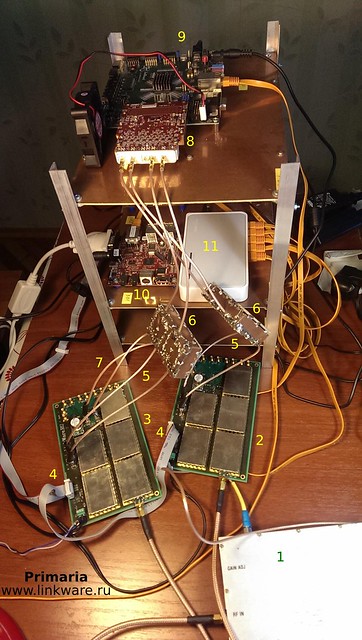Prim Ceramic 2700 Signal Processing Unit contains a chain RF Module -> ADC – > FPGA -> DSP. In the terminology of PCL, the unit is a frequency channel, or a bistatic section. Prototype includes two bistatic sections, allow resolve targets due to crossing two ambiguity ellipses.

Passive Padar Signal Processing Unit: RF module, high performance ADC and Signal Processor based on ARM/FPGA cores
On the photo bottom there is the RF module that provides gain and reception signal from the PCL antenna system. RF module is designed and manufactured by Primaria for the product line associated with the radio signal processing, especially for PCL. Output of the module performs two analog I / Q channels. The RF module provides I2C interface for remote control and configuration. The module has a synthesizer and a local oscillator used in the the Master mode. In the Slave mode, the reference frequency received from the other RF module which operates in Master, for coherent reception and processing of multifrequency.
Board features:
- input frequency range: 50 MHz – 2 GHz
- synthesizer stability: 10-7
- input noise level: 6 dB
- IF bandwidth: 5 – 240 MHz
I/Q components from RF module feed via coaxial cable to the high speed ADC on the mesonin board with high – density FMC connector.
PCL prototype Signal Processor is based on ZedBoard kit (on the photo top) with ARM and FPGA cores. On the right side of the board there is a FMC connector that is connected to a high-speed four-channel ADC board. ZedBoard feeds the parallel ADC samples to FPGA and then processed data direct to the ARM core. Vivado tools are used for the ARM and FPGA cores software development. ARM kernel is running under Linux Embedded.
Then, module BearleBoard provides FFT with DSP for calculation two-dimension ambiguity function.
The signal processor digitizes coming from RF module I/Q signals at a rate of 250 M/samples per second parallel data using 16-bit ADCs. To increase the dynamic range oversampling technology and special digital signal filtering are used.
The signal processor performs the following functions as PCL bistatic section:
- adaptive filtering based on the Gram – Schmidt orthogonalization procedure and multiple regression filter;
- continuous calculation Ambiguity Function matrix with the dimension Range bins x Dopler bins;
- plot extractor based on an CFAR algorithm.
Produced plots are packed into the stream with frame structure and transmit on a prototype multistatic section via Ethernet internal network.
The number of the “Prim Ceramic 2700” prototype Signal Processors corresponds to the number of bistatic radar sections, that is depends on the number of frequencies used.
Multistatic processing is implemented on a multi-core x86 platform and provides the target associations, ambiguity resolution and building targets tracks.
The photo below shows the assembly of the prototype. Numbers denote:

Assembled PCL Prototype”Ceramic-2700.
1. Antenna Steering Unit
2. Target Channel (Reflected Signal)
3. Reference Channel (FM Stantion Singnal)
4. Control interface I2C for the RF modules: set frequencies and other parameters
5. IF I/Q output
6. Pass – band filters
7. Reference frequency for coherent two channels
8. Hi speed 2x channel ADC FMC module with 250 MSamples/s, producing 16 – bit I/Q
9. 2x channel adaptive filter based on ARM / FPGA
10. ARM / DSP board calculate ambiguity function and plots with CFAR method
11. Ethernet switch linking modules
Multichannel and tracking processing perform on external PC, using Python OpenGl modules for real-time displaying targets.
